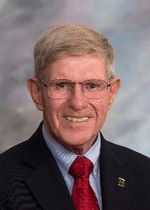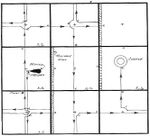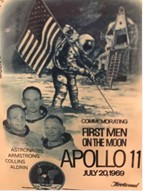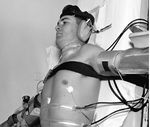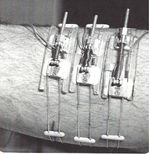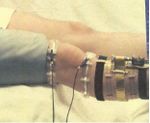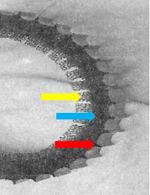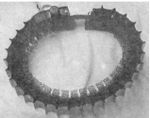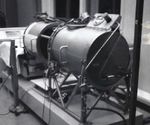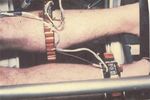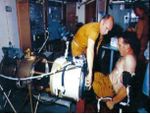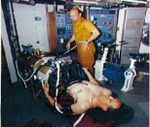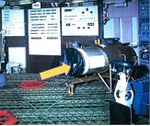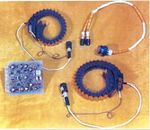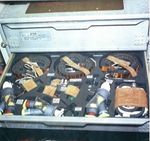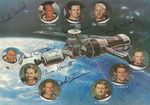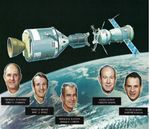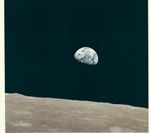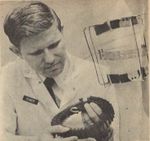First-Hand:Understanding Weightlessness
Submitted by Richard J. Gowen, Ph.D., FIEEE, IEEE Centennial President and IEEE Foundation President Emeritus, South Dakota School of Mines and Technology President, Dakota State University President
May 22, 2020
Overview
In 1964, it became my privilege to lead a research team to develop the capability for the National Aeronautics and Space Agency (NASA) to evaluate physiological changes in astronauts that occurred during the weightlessness of zero gravity spaceflight. My preparation to lead a NASA research program began with my undergraduate studies at Rutgers University and my decision to explore the design and development of a computer. I built the computer, and it was a success that led to an invitation to join the RCA Corporation research group. I was called to active duty with the Air Force which included teaching at the Air Force Academy and the invitation by NASA to join the medical launch and recovery program.
The activities of the research team evolved to provide support for the NASA Skylab missions and simultaneously support the educational mission of the Air Force Academy. Our focus on the Skylab missions centered on evaluating changes in the cardiovascular system during the astronaut missions. There were three Skylab missions with the first mission lasting 28 days and the next two missions each lasting 56 days. Among our initial tasks was to construct a laboratory facility to virtually test and evaluate the changes in the astronauts during the spaceflight missions. We prepared a facility that converted a teaching laboratory at the Air Force Academy into a lab with the capability to test and evaluate faculty and cadets for understanding cardiovascular changes.
The preparation to test and evaluate changes in the cardiovascular system of astronauts led to the development of a lower body negative pressure device (LBNPD) capable of varying the differential pressure between the lower and upper body of each astronaut. We developed the LBNPD to enable the use of the vacuum of space to create a differential pressure between the upper and lower body. LBNPD’s has the capability to vary the transfer of body fluids from the upper to lower body was the ability to evaluate the movement of fluids on the cardiovascular system.
Becoming A Computer Programmer
In my junior year at Rutgers University, I became interested in computers. After reviewing the computer articles from IEEE, I decided to build a computer. I chose to build “Michael, the Maze Mastering Mouse” that would control an electrical device to navigate a maze of partitions to find a pathway to a simulated piece of cheese. A month before graduation from Rutgers, I was pleased that “Michael, The Maze Mastering Mouse” was a great success. The computer program operated a digital “mouse” located on top of a 3-foot square glass plate that was an XY plotter. The objective of the computer was to move the “mouse” to find an open pathway through the “maze” of partitions and locate a digital “cheese”. The “maze” of partitions in the sidewalls had also been placed on top of the glass plate to create the “maze”. As shown in Figure 1, there were nine squares of the ”maze”, a “mouse”, and the “cheese”. The partitions provided definition for the ”mouse” to identify the pathway to the “cheese” and were easily altered by changing the sidewalls of the “maze”.
The computer had over 10 cubic feet of electrical relays that enabled the computer to remember the pathway that the XY plotter moved the digital “mouse” to check each of the partitions. When the XY driven “mouse” found an opening in the partitions, the ”mouse” continued to search the “maze” until the “cheese” was found. Once the “cheese” was located, it was possible to place the “mouse” anywhere in the “maze”, and it would move directly to the “cheese”. If the partitions of the sidewalls were moved, the digital “mouse” would continue the search for the cheese.
My involvement with IEEE began when I joined as a student member in 1956 in my junior year at Rutgers. My decision to join the IEEE offered numerous opportunities to give back to the engineering profession, gain leadership skills, and serve on boards and committees. As an IEEE volunteer, I was active in the Denver (CO) Section and assisted in establishing the Pikes Peak Section in Colorado Springs as a founding member. In 1976, I was elected to the IEEE Board of Directors as Region 5 Director and began to serve on the major boards of the IEEE. I served as President of IEEE-USA and was a member of the Regional Activities Board (RAB), Standards Board, Technical Activities Board (TAB), and was elected to be an IEEE Fellow in 1981.
The IEEE has roots that go back to Edison and Bell and was going to celebrate 100 years of technological achievement in 1984. I was pleased to be the first member of the IEEE Board of Directors elected by the members of IEEE to be the Centennial President in 1984. The IEEE Centennial Year was celebrated by presenting awards and commendations to IEEE members in 48 countries. After my worldwide experiences as IEEE President, I became a member of the IEEE Foundation and served as the President of the IEEE Foundation for 10 years. Those experiences have led to becoming a director of the board of a supercomputer company, President of two public higher education universities, the Executive Director for the conversion of an eight-thousand-foot underground mine that has become an international laboratory, President of a non-profit teaching computer coding, and many similar opportunities in visionary and strategic leadership roles.
RCA Corporation
Perhaps the most interesting part of designing “Michael, the Maze Mastering Mouse “ was that scientists at RCA Corporation became aware of my efforts to build a computer. RCA gave me the best employment offer I had as a new 1957 graduate of Rutgers University. I was given a dream job as a researcher. I was asked to join the group developing a potential large screen monitor for applications in television or computing. The potential design required nonlinear digital systems, and I began to test and evaluate nonlinear materials for applications in the control of a potential video screen. Regrettably, my time as a researcher for RCA was dramatically changed when I was called to serve the needs of our country as a member of the U.S. Air Force.
U.S. Air Force
I was selected as part of a group of ten electrical engineers to join the Air Force to counter the Soviet Union threat to fly beneath the scan of radars in the U.S. Defense Early Warning System (DEW). The Air Force had expedited the construction of Gap Filler radars to be located at the lowest parts of the DEW line. After six months of orientation and training, I was assigned as the Communications Electronics Officer at Yaak Air Force Station, Montana, and quickly discovered the need to retrofit the Gap Filler radars located in both Idaho and Montana.
While I was at Yaak, the Air Force Academy announced an opportunity to join the electrical engineering faculty. My application was accepted, and the Air Force Academy sponsored my post-graduate studies at Iowa State University (ISU) in preparation to become a member of the faculty. My doctoral studies majored in electrical engineering, with minors in mathematics and biomedical engineering, which was a new area. My research specialized in the cardiovascular aspects of blood pressure and included developing a new way to measure blood pressure during exercise that was patented and has become widely used. After 30 months at ISU, I thought that I had completed all requirements for graduation. I was surprised to learn that ISU expected the Air Force to provide an additional three months of funding so I would comply with the University’s requirement for 33 months of study for the doctoral degree.
Vasomotor Control
With only three months to complete a research program, I chose to continue my blood pressure research by testing and evaluating the relationship of vasomotor control and blood pressure. The study of vasomotor control integrates the many functions that comprise the cardiovascular and neural components of the human body. Vasomotor control provides the cardiovascular system the ability to regulate the distribution of blood through the many veins and arteries of humans. The principal objective of vasomotor control is to balance the need for adequate perfusion of blood to the brain while maintaining needed distribution of blood throughout the rest of the body. This vasomotor control research became central to a comprehensive understanding I would apply to the cardiovascular balances of body fluids in astronauts for long duration zero gravity space missions. The three-month vasomotor control research study also included the evaluation of cardiovascular changes in animals with changes in vasomotor control.
U.S. Air Force Academy
After completing all the requirements for graduation from Iowa State University in 1962, I became an instructor in the electrical engineering department of the Air Force Academy. NASA was selecting Science Astronauts for the Apollo space missions. I applied and was selected as one of the 11 candidates to be screened for possible selection to become an astronaut. In December 1966, I was anxiously awaiting the call to travel to NASA Johnson Space Center to be part of the Apollo space missions and for my qualifying examination to become an astronaut. I took my children ice-skating and regrettably, I fell on the ice. Ten days later, I could no longer walk. Fortunately, back surgery was a success, but I continue living with back problems. I came home from the hospital on the same day as the Apollo 1 tragic fire which took the lives of the three astronauts within fifteen seconds. With the back surgery, I was no longer qualified to compete for a science astronaut position.
My involvement with NASA continued when I became part of a biomedical research team seeking to understand the effect of weightlessness on the cardiovascular system. Space missions would put the human body in unknown territory. The research team sought methods to determine the effects of long-duration zero gravity on the cardivascular system. Apollo 11, as shown in Figure 2, was the first time that man walked on the moon. Neil Armstong’s statement heard throughout the world, “That’s one small step for man, one giant leap for mankind” kept us inspired in our research.
Developing the Research Program
The activities of the research team evolved to provide support for both the NASA Apollo and Skylab missions and continue to support the educational mission of the Air Force Academy. Our focus on the Skylab missions centered on evaluating changes in the cardiovascular system during the longer duration astronaut missions. There were three Skylab missions with the first mission lasting 28 days, and the next two missions each lasting 56 days. Among our initial tasks was to develop a laboratory facility to virtually test and evaluate the changes in the astronauts during the spaceflight missions. We converted a teaching laboratory at the Air Force Academy into a facility with the capability to test and evaluate faculty and cadets.
Fortunately, we were able to develop a faculty test and evaluation group of Air Force officers who had prior flying experience that was equivalent to the flight experience of the NASA mission crews. This faculty test and evaluation group provided the ability to virtually evaluate the cardiovascular changes that occurred to the astronauts during their flight missions.
The preparation to test and evaluate changes in the cardiovascular system of astronauts led to the development of a lower body negative pressure device (LBNPD) capable of varying the differential pressure between the lower and upper body of each astronaut. We developed the ability to use the LBNPD to enable the use of the vacuum of space to create a differential pressure between the upper and lower body. The LBNPD became an important tool to successfully understand the impact of the weightlessness of zero gravity on the cardiovascular system of astronauts flying long duration missions.
Tilt Table
With the completion of the new long-term research facility housed in the Department of Electrical Engineering of the Air Force Academy, we began to investigate how we would be able to use the LBNPD to test and evaluate the cardiovascular system. We sought to better understand the science of cardiovascular change in the weightlessness of long duration space missions.
We began our evaluation of the effect of changes with a widely used Tilt Table science evaluation of the physiological effects of a rapid shift of body mass. The Tilt Table provides the capability to shift a subject from lying in a horizontal position to a vertical position. The Tilt Table has the capability for the subject to sit on a ledge so that there will be no need to use the muscles of the legs when the subject is rapidly changed to the vertical position as shown in Figure 3. In the earth gravity environment, the Tilt Table is widely used by scientists to measure the shift in body mass.
The test subject was instrumented for both the traditional Tilt Table evaluation and the start of the evaluations for Skylab. In the earth environment, mercury strain gauges were placed on the calf of the legs as shown in Figure 4. The subject was then rapidly tilted from the horizontal position to the vertical position and monitored for changes in the circumference of the legs. While the results of this test validated the expected increase in the circumference of the legs, the Tilt Table and strain gauges were not candidates for a testing evaluation program in a zero-gravity environment.
Optical EKG System
While considering possible solutions for applications in zero gravity, two of the three astronauts of the Apollo 15 mission developed tachycardia which raised concerns about the ability to continue flights to the moon. There was a need to provide x-ray images of the hearts of the astronauts scheduled for the next moon mission. There were also concerns in connecting an astronaut for an EKG in the shipboard environment of potentially dangerous leakage currents.
An optical link was developed to connect an EKG from the body of an astronaut to the shipboard x-ray unit. The system of EKG optical link, processing computer, and x-ray machine was used to produce images of the hearts of astronauts for all flights from Apollo 16 through Skylab and Apollo-Soyuz missions.
New Approach Needed
The requirements for the system to monitor the cardiovascular changes occurring in astronauts with long duration mission exposure to weightlessness led to the use of a leg cuff charged with air, as shown in Figure 5, to control the amount of body fluids in the upper portion of leg. While this was a usable system for some subjects, it was unacceptable because of the interactions of the electrical impedance and the body chemistry of some of the potential subjects.
A new approach began to evolve that would use an electric capacitive to measure the small changes in the dimensions of the skin of the leg in comparison with the changes in the overall leg volume. This system would shift the concerns from passing an electrical impedance current through the leg to a system focused on controlling the movement of the fluid body masses of astronauts.
Capacitive Plethysmograph
The ideal system for Skylab evolved into the use of a lower body negative pressure device (LBNPD) to provide a differential pressure between the lower body and the upper body. The LBNPD used the vacuum of space to provide negative pressure in the lower body relative to the upper body during cardiovascular tests and evaluations. The fluid in the legs of the lower body are continuous with the upper body. A lower pressure in the lower body relative to the upper body caused the flow of body fluids to the lower body. This flow of fluids to the lower body increased the overall size of the legs of the astronaut. Rather than attempt to measure the full mass of body fluids flowing into the leg, we concentrated on the increase of fluids into the calf of the leg.
While the LBNPD provides the ability to move fluid body mass, there was a need to measure the small changes in the size of the legs with the application of external suction. An electric capacitor was developed with the separation between the two plates of the capacitor determining the capacitance. The skin of the surface of the leg became the one movable plate of the capacitor. The second plate of the capacitor was to be located a fixed distance from the skin of the leg. Layers of foam created the separation between the plates. Combined, the features provided a capacitive plethysmograph.
The key role of the first layer of foam was to have the side of the foam touching the leg with the increase in pressure on the skin of the leg. In Figure 6, the yellow arrow points to the first layer of foam that is 95% air and is segmented to become very flexible.
The first layer of foam of Figure 6 is compacted by the increase of the skin of the astronaut and the capacitance increases. The blue arrow of Figure 6 points to the dense collection of foam that stabilizes the leg bands and provides the second plate of the capacitor. The red arrow of Figure 6 points to the copper shield that provides electrical insulation for the leg band.
In Figure 7, there is a cross section of the first layer of foam that shows the leg band has two arms that touch the skin of the calf of the leg of the astronaut. The two arms of the first layer of foam are in contact with the skin of the leg of the astronaut. As the skin of the leg increases in volume, it begins to compact this layer of foam.
Leg Bands
The purpose of the capacitive plethysmograph was to transduce changes in the volume of the leg during the test and evaluation of astronauts in weightlessness. As shown in Figure 7, the leg band includes the capacitor electronics, the calibration plate, and the spring link to close the ends of the leg bands to maintain the calibration. Each of the foam layers of a leg band were 1 inch wide, and the length was the distance needed to wrap this layer around the calf of the leg.
The capacitive plethysmograph was a very sensitive instrument and has been described as “tying the knot in a coaxial cable”. Key to the capacitive function was the different thickness and density of the two foam layers. The foam layer shown by the yellow arrow of Figure 6 was less dense and very flexible. During operation, the increase in the leg volume compressed the skin (first capacitor plate) against this flexible foam layer. In turn, this compression pushed into the second, thicker lay of foam (second capacitor plate) shown by the blue arrow of Figure 6.
The change in size of the leg increased with the suction from the LBNPD, however the expansion of the skin into the flexible foam was very small. It is helpful to recall that the formula for the circumference of the leg is 2πR with the radial dimension R. In comparison with the circumference of the leg, the radial dimension is less than one sixth the circumference. Albeit small, the compaction of this first layer was enough to measure the small increase of the leg volume that resulted in a capacitance change.
Humidity Adjustment
The lower body of the astronaut contained in the LBNPD sweats which raises the level of humidity in the LBNPD. The increased humidity in the LBNPD also raised the indication of the volume of the leg. It was necessary to remove the increased humidity from the determination of the leg volume measurement. Figure 8 shows the legs of the astronaut during the lower body negative pressure evaluation. Please note the difference between the two bands on the legs of the astronaut. The top leg band was an active transducer and measured changes in the lower body negative pressure. The lower right leg band measured only humidity because the leg band was placed on the fixed diameter metal band. This provided the basis for humidity adjustment. The indication of humidity from the fixed circumference band on the right leg was subtracted from the pressure indicated by the active capacitive plethysmograph on the other leg. The effect of humidity was no longer part of the pressure measurement.
Operating Plethysmograph
Figure 9 shows a capacitive plethysmograph that was operational during the space missions. Each of the capacitive plethysmographs was a precise instrument with the circumference of each leg band recorded and became a part of the database for leg bands. Each of the leg bands was measured and linked to the calibration plate of the leg band as shown in Figure 7.
Prototype Lower Body Negative Pressure Device
The need to move body mass during testing led to the application of vacuum suction to move body fluids. A prototype design was constructed to create a separation of the upper and lower body of the astronaut. A lower body air tank was prepared with a seal separating the astronauts upper and lower body. The lower body had an opening to permit astronauts to slide into the tank. The Air Force Academy cadets and Major Gowen (later promoted to Lieutenant Colonel) are observing a test subject in the LBNPD prototype in Figure 10. This design review and discussions included concepts from this initial LBNPD prototype to be included in the Skylab missions.
On the prototype, the tank had 8” x 12” doors on each side at the level of the leg calf of a test subject laying in the tank. These doors permitted the adjustment of transducers to measure changes in the size of the leg calf of each astronaut. However, the doors were replaced by providing the ability to slide open the LBNPD to adjust the leg bands. This model was a prototype for the LBNPD that was being developed for use on the Skylab long-term astronaut missions with one flight of three astronauts for 28 days and two flights each of 56 days of spaceflight missions.
Skylab LBNPD
Figure 11 shows the initial Skylab version of the LBNPD with a test subject in the tank and ready to be connected to the vacuum of space. The controls are set to the level of suction to achieve the differential pressure between the lower body and the upper body.
Figure 12 shows the Space Flight Version of the Lower Body Negative Pressure Device. The Skylab LBNPD was designed to open the tank for ease of attaching the leg band capacitive plethysmograph to the calf of the astronauts prior to the start of the Skylab mission evaluation. The vacuum of space was attached to the tank with valves to limit the amount of suction. The vacuum suction created a differential pressure between the lower and upper body of the astronaut. The effect of this differential pressure was to provide the upper body without suction to remain at the pressure established by the overall Skylab pressure airflow system.
The differential pressure between the lower and upper body of the astronaut used the suction to reduce the pressure on the legs of the astronaut. The measurement of the differential pressure was made with the capacitive plethysmographs placed on the legs of the astronaut. The first capacitive plethysmograph recorded the differential pressure between the Skylab spacecraft and the lower body of the astronaut. A second capacitive plethysmograph was also placed on the leg of the astronaut. However, this plethysmograph was placed around the metal band that limits the change of the pressure. This metal band provides the level of humidity for the purpose of correcting the pressure in the active plethysmograph to remove the effect of humidity.
Figure 13 shows the Skylab capacitive plethysmographs on the calves of the legs of an astronaut. The Skylab LBNPD was able to be opened to enable the adjustment of the plethysmographs to measure changes in the volume of the calf of the leg and verify the operation of the humidity balance system.
Qualification Testing
A 56-day land-based test of the instrumentation was operated by NASA with a crew of three astronauts. The LBNPD was pressurized to simulate an altitude to be flown in space on the Skylab Mission.
Figures 14 and 15 show Dr. Thornton assisting the astronauts entering the LBNPD to prepare for a Skylab evaluation of the changes in lower body physiology.
Astronaut Dr. William Thornton led the critical evaluation of the equipment that was being prepared for the long duration Skylab zero gravity tests and evaluations. Our leg bands looked fragile because of the need to avoid inhibiting the expansion of the calf of the legs and the flexible foam to measure capacitance.
The recap of the Skylab equipment review included an interesting revelation. Dr. Thornton held up one of our leg bands and commented to the group that included me that “this leg band was one of the few items that worked the way it should have”.
As we continued developing the leg bands, Dr. Thornton became a mentor for our research team. He advised us on the laboratory bed rest study to correlate the data from Skylab with our ground-based test and evaluation.
The LBNPD is placed in the test and evaluation area of the Skylab mission. The LBNPD is shown in Figure 16 with a tan arrow pointing to the entrance of the LBNPD where astronauts move into the capsule with their legs first.
During each day of the space mission, an astronaut entered the LBNPD for test and evaluation that was scheduled for 25 minutes. An additional 20 minutes during the test provided for the adjustment of the active plethysmograph leg band and the adjustment of the humidity balance.
The LBNPD was used to establish a controllable suction to test and evaluate the cardiovascular response of the astronauts to negative pressure in the lower body chamber. The LBNPD 25-minute suction leg volume protocol automatically varied a five-step suction process.
Astronaut Owen Garriott, the science astronaut with a Ph.D., is shown entering the LBNPD during an in-flight test and evaluation procedure as shown in Figure 17. Astronaut Garriott’s mission was to evaluate the cardiovascular system during long-duration manned missions. The goal was to better understand the interaction of weightlessness on the cardiovascular system. Please note there is no need to support the upper body outside of the LBNPD as Astronaut Garrett’s body is weightless in space.
Leg Volume Protocol
The increase in the leg volume of each astronaut provided a measure of the physiological changes that occurred during the spaceflight mission. Each astronaut was evaluated every third day of the mission. The overall evaluation was scheduled for 25 minutes as shown in Figure 18. The Test Protocol began with a five-minute control period with the astronaut at rest. The test and evaluation continued with five segments of LBNPD with the air pressure changed to the levels of the Figure 18 diagram. The -8 and -16 segments identified the flow of body fluids largely from the venous vascular system. The remaining three segments on Figure 18 show the body mass from this portion of the lower body. The astronaut then concluded the test and evaluation with a period of five minutes of rest and recovery.
Skylab Mission Data
Skylab was launched from the Kennedy Space Center using a Saturn V third stage vehicle. The plan was to launch three astronauts on the second day to begin the first 28-day Skylab mission. However, one of the space energy orbital panels did not deploy, and NASA modified the Skylab plan to accomplish the mission objectives. The first Skylab was launched to accomplish a strenuous program of tests and evaluations. There were several experiments on the Skylab, and this report will focus on the missions to test and evaluate the effects of weightlessness on the cardiovascular system.
The following Skylab mission data are illustrative of the test and evaluation of the cardiovascular system in leg circumference and body mass changes with the weightlessness of three Skylab missions. As shown in Figure 19, the presentation begins with the cardiovascular related data for changes in the leg circumference and body mass for the collective Skylab weightlessness data.
The most significant changes in the calf of the leg circumference occurred in preflight and show the effect of LBNPD.
Leg Bands in Space
Figure 22 shows the capacitive plethysmographs with two leg bands, electronics module, and interconnecting cables. The leg bands show the outer layer of formed copper shield and the location of the electrical equipment for the operation of the leg band. There are two cables that connected the leg bands into the lower body electronics with one leg band providing the change in volume and the second leg band measuring the humidity in the LBNPD and correcting volume pressure for humidity.
The Skylab leg bands were packed in a special transfer case as shown in Figure 23 and loaded on Skylab. The leg bands were transferred to Skylab for the test and evaluation of cardiovascular weightlessness studies in space. The capacitive plethysmograph of each leg band functioned well throughout the extended duration of weightlessness in Skylab.
One of the bands that flew on Skylab was returned from space and transferred to the Smithsonian Air and Space Museum and was displayed in the space mission section.
Skylab Astronauts
As shown in Figure 24, the nine astronauts who flew on the Skylab missions are pictured with Skylab 2.
While under contract with NASA, the NASA Research and Development Team completed several reports. The NASA R&D team did an incredible job with the long duration weightlessness flights in zero gravity. With an astronaut undergoing test and evaluation in the LBNPD each day, the evaluation of the test data required weeks of observation and analysis.
While there were many significant observations from the long-duration missions in weightlessness, perhaps the most interesting and significant data came from the recognition that the leg’s small arteries and veins exhibited muscular capability which would change the direction of flow of the body fluids.
Apollo-Soyuz Project and Astronauts
Dr. David Carol (Major Carol at the time of the project) represented the US Air Force Academy research team on test and evaluation of long-duration flights on weightlessness during the time of the Apollo-Soyuz project. The Apollo-Soyuz project in conjunction with three US astronauts and two Russian cosmonauts of the Apollo-Soyuz Project as shown in Figure 25. Dr. Carol provided access to the leg bands for use during the flight. I greatly appreciate all that Dr. David Carol did for our research test and evaluation of the cardiovascular system changes observed during the Skylab zero gravity missions.
Return to Earth
It was a special privilege for me to work with the leaders of the medical launch and recovery team to prepare the capability to evaluate the cardiovascular response of astronauts during the long duration spaceflights. The astronaut crew members would finish their flight to the moon, Skylab missions, or an Apollo-Soyuz Project with a “splash down” in the Pacific Ocean and be recovered by a U.S. Navy aircraft carrier as shown in Figure 26.
Beginning with Apollo 16, the spacecraft crew members were in my shipboard lab within minutes after they returned to the flight deck of the recovery ship for evaluation of physiology changes that may have occurred during their spaceflight. The concerns for the ability to participate in long-duration missions were alleviated by the pre- and post-flight data collected by the laboratory team of scientists and technicians. The research results paved the way for understanding human physiological changes due to long duration periods of zero gravity. The LBNPD continued in a new, collapsible version for use on Space Shuttle missions.
A special thank you to all involved for the documentation of A Quest for Understanding of Weightlessness.
Teammates
The results of these cumulative evaluations along with the preparation of concepts and equipment were the work of ten scientists and technicians who operated the Department of Electrical Engineering at the Air Force Academy research laboratory. It is with the greatest of respect and fond memories that I recall these incredible teammates.
As the Skylab and other astronauts returned from their journey from space to earth, they had the opportunity to ponder the incredible significance of the experience they had just completed. While I have gained tremendous experiences, it is significant to wonder what would have occurred if I hadn’t fallen when I took the children ice-skating?
About Dr. Richard J. Gowen
The evolution of the capacitive plethysmograph started with the Friday evening initial concept for the leg bands which were made with coat-hangar wires, rubber bands, and brass plate as shown on the mannequin leg (upper right in the picture) in Figure 28. On the following Monday morning, Dr. Gowen shared the concepts for the capacitive plethysmograph with a NASA team at the Air Force Academy. The detailed design and development continued with input from NASA Johnson Space Center and the construction of the capacitive unit was made by Martin Marietta Corporation in Denver, Colorado.
Dr. Gowen retired in 1977 as an US Air Force Lt. Col. He served as the vice president of the South Dakota School of Mines and Technology for seven years, and in 1984 was appointed by Governor Janklow to change the mission of Dakota State University to a cybersecurity University. In 1987, the South Dakota Board of Regents appointed him as the President of the South Dakota School of Mines and Technology, a position he held for 16 years until his retirement in 2003.
Dr. Gowen’s leadership skills brought him as IEEE Centennial President in 1984 to IEEE celebrations throughout the world and then to the IEEE Foundation as President for 10 years. He also has been a member of the board of ETA Supercomputer corporation, and he led the conversion of the Homestake gold mine to become an 8000 ft deep underground science laboratory (SURF). He led the production of a strategic electric drive system company (DPLWED) and is currently the President of Excellence in Computer Programming (ECP) which teaches computer learning through the Internet.
List of Figures
- Figure 1. Michael, The Maze Mastering Mouse, 1956
- Figure 2. Apollo 11, 1969*
- Figure 3. Subject on the Tilt Table
- Figure 4. Mercury Transducers
- Figure 5. Testing Electrical Impedance to Measure the Size of the Calf
- Figure 6. The Foam Layers
- Figure 7. Diagram of Capacitive Plethysmograph
- Figure 8. Plethysmograph Leg Bands*
- Figure 9. Capacitive Plethysmograph Leg Band
- Figure 10. Prototype of Lower Body Negative Pressure Unit
- Figure 11. Test Subject in Lower Body Negative Pressure Device (LBNPD)*
- Figure 12. The Space Flight Version of the Lower Body Negative Pressure Device*
- Figure 13. Skylab Capacitive Plethysmographs Placed on Calves of Astronaut*
- Figure 14. Astronaut entering LBNPD for Evaluation*
- Figure 15. Dr. Thornton and the Astronaut who is in the LBNPD*
- Figure 16. Lower Body Negative Pressure Device on Skylab 2 while in Space*
- Figure 17. Astronaut Owen Garriott entering the Skylab 2 LBNPD preparing for an In-flight Cardiovascular Test and Evaluation*
- Figure 18. Profile of the Lower Body Negative Pressure Evaluation
- Figure 19. Skylab 3 Leg Calf Circumference Data
- Figure 20. Skylab 3 Body Mass Data
- Figure 21. Skylab 3 Body Mass Data
- Figure 22. Capacitive Plethysmographs*
- Figure 23. Skylab Leg Band Transfer Case*
- Figure 24. Skylab 2 Astronauts*
- Figure 25. Apollo-Soyuz Astronauts*
- Figure 26. Splashdown - Ready for Pickup*
- Figure 27. Picture of Earth from Skylab Just Leaving the Surface of the Moon
- Figure 28. Evolution of the Leg Bands
(*) Images via NASA public domain images
References
Barnett, Richard D., Gowen, Richard J., Lt. Col., USAF, Carroll, David R., Major, USAF, Analysis of Changes in Leg Volume Parameters, and Orthostatic Tolerance in Response to Lower Body Negative Pressure During 28-Days Exposure to Zero Gravity Skylab 2, March 1975
Barnett, Richard D., Gowen, Richard J., Lt. Col., USAF, Carroll, David R., Major, USAF, Analysis of Changes in Leg Volume Parameters, and Orthostatic Tolerance in Response to Lower Body Negative Pressure During 59-Days Exposure to Zero Gravity Skylab 3, July 1975 (Update: the first spaceflight was 56 days)
